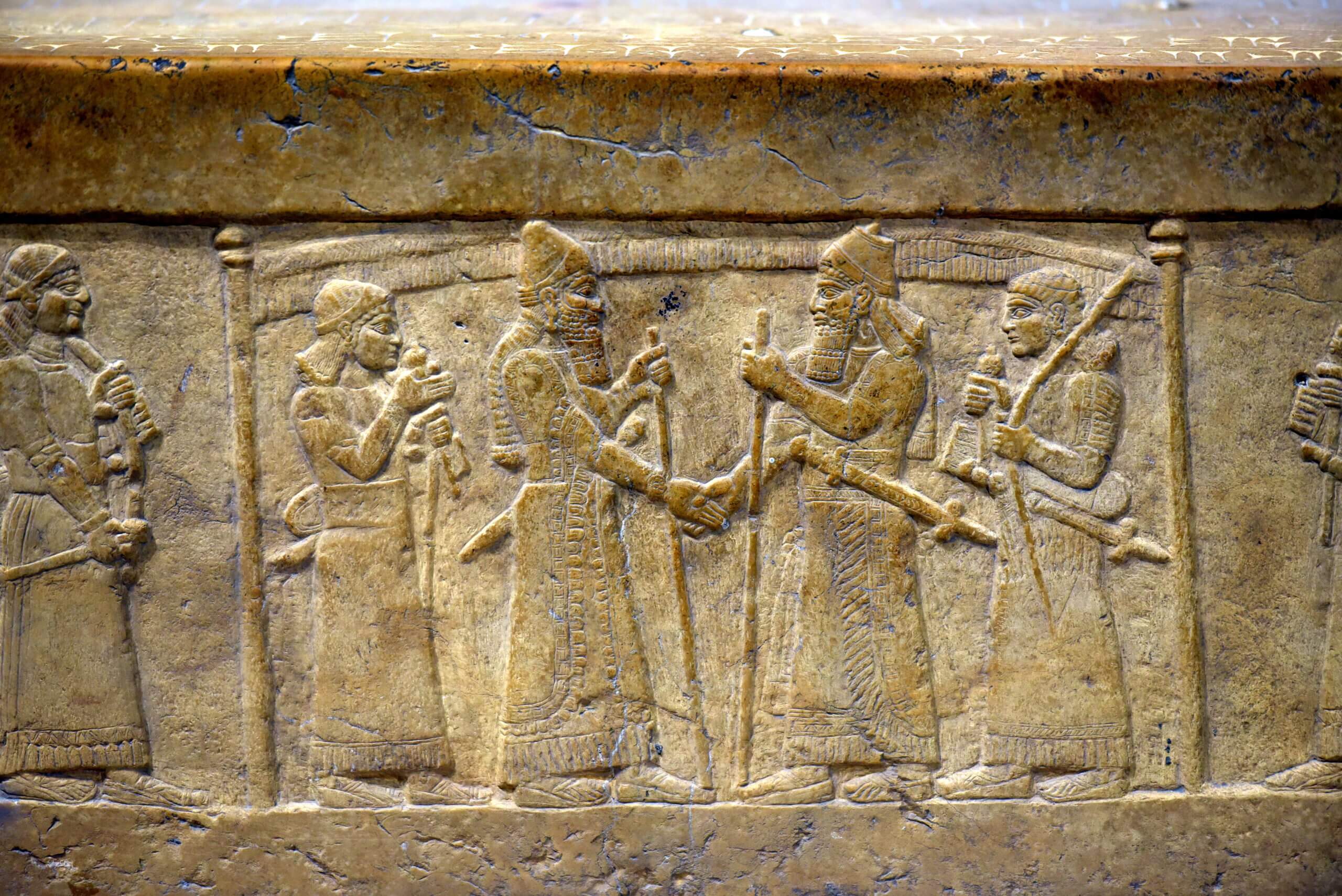Market Overview
The last handshake
Remember when you knew you had a deal when you shook hands on it? Those days are as clear in memory as if they were only six months ago. Alas, this might be the end of days for the time-honored custom of pressing the flesh.
The handshake, it must be said, had a good run.

King Shalmanser III of Assyria greets Babylonian King Marduk-zakir-shumi I (“Call me Marty”) in the 9th century BC. Credit: Osama Shukir Muhammed Amin, Iraq Museum
Putting the “Bro” in “Bronze Age”
The first record of a handshake is carved into the throne dais of Assyrian King Shalmanser III (known to Biblical scholars as the one who subjugated the northern Kingdom of Israel), to mark his allegiance with Babylonian King Marduk-zakir-shumi. We can only assume that this was already a common custom, as this occurred in the first millennium B.C. and the region had already been organized into kingdoms comprised of city-states for 5,000 years at that point.
About 400 years after that royal greeting, the custom found its way to Greece, where they gave a name to the gesture: dexiosis. We’ve been doing it all our lives, and probably nobody writing, editing or reading this piece ever heard that word before. Don’t feel bad. Microsoft Word’s spell checker hasn’t either.
Still, handshaking wasn’t universal. Mohammed, the founder of Islam, came along about a thousand years after the word “dexiosis” was coined, and was apparently unaware of the custom until he was introduced to visitors from Yemen.
And yet it might have far predated the settlement of Mesopotamia. According to one Israeli study, “handshaking may functionally serve active yet subliminal social chemosignaling, which likely plays a large role in ongoing human behavior.” In other words, maybe we shook a stranger’s hand in order to get their scent on our own hand, so we could literally sniff out information about their health, diet, degree of sexual arousal or other pertinent information. When it comes to greeting, then, the only difference between our ancestors and our dogs’ ancestors was subtlety.
Variations on the theme
As successfully as handshaking has been at transcending cultures, it has grown new roots in every culture that adopted it. Austrians would shake hands upon meeting anyone, even children. In the Middle East handshakes were offered gingerly, and the firm grip of Americans was considered rude. Chinese handshakes were also soft, but lasted for an extended time. Japanese considered it a foreign custom and only practiced it with foreigners.
Who initiated a handshake was also a matter a context. Did the person entering the room make the rounds? Or did that person wait to be approached, likely by the eldest one there? Was there a protocol determining whose hand got shaken first?
And then there was the whole gender norm dimension. It was originally a greeting between two men. Women didn’t practice it until fairly recent human history, and then not universally. We remember being taught to shake a woman’s hand gently, then going to work in the Fortune 500 world around the time that glass ceilings were cracking on every floor. Suddenly, women had acquired arm wrestlers’ grips, and expected their male counterparts to reciprocate, demonstrating that we all saw each other as equals.
Yet the female-male handshake never made it all around the world. There are still countries where it is scandalous, if not flat-out illegal, for an unrelated man to touch a woman, even in a gesture that’s so widely considered innocent.
Waving goodbye?
There’s a lot of past tense under that previous heading. Is the handshake really dead?
Who knows? But one thing is certain: We learned we can do without it. Absent the novel coronavirus, shaking hands is still inviting infection. It’s long been a leading cause of the spread of influenza, scabies and who-knows-what-else. The internet is alight with studies suggesting that handshakes spread more germs than kisses.
“People’s hands touch way more than their lips,” as one Penn State blogger put it.
And, fellas, let’s be honest. Two-thirds of us don’t wash our hands with soap after going to the toilet. There’s plenty of science behind that claim. In 2008, a team of six British researchers discovered this by spending two months observing restrooms at a highway service station, then published their findings in the American Journal of Public Health. Disgusted? Good. More of us should be.
So even after we finally acquire that fabled “herd immunity” to covid-19, maybe we shouldn’t be in a rush to get back to shaking hands. There are options. Perhaps we won’t follow the Japanese example and bow, but India’s “namaste” custom is charming, as is the similar Thai “wai”. Meantime, fist bumps, elbow bumps and jazz hands seem to be filling the gap. Placing your hand over your heart is a nice gesture but might be seen as overly reverent. The shaka sign – used by surfer dudes to express “hang loose, bruh” – is also a nice gesture, but might be too familiar.
Hey, how about just smiling?



